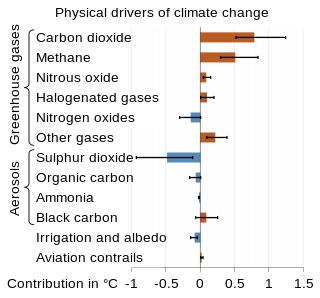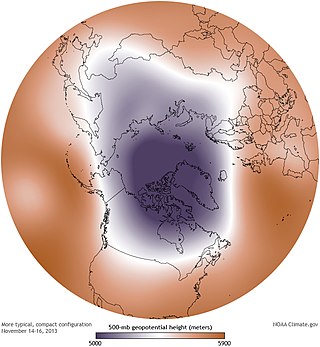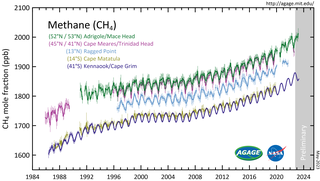Related Research Articles

The tropopause is the atmospheric boundary that demarcates the troposphere from the stratosphere, which are the lowest two of the five layers of the atmosphere of Earth. The tropopause is a thermodynamic gradient-stratification layer that marks the end of the troposphere, and is approximately 17 kilometres (11 mi) above the equatorial regions, and approximately 9 kilometres (5.6 mi) above the polar regions.
A sudden stratospheric warming (SSW) is an event in which polar stratospheric temperatures rise by several tens of kelvins over the course of a few days. The warming is preceded by a slowing then reversal of the westerly winds in the stratospheric polar vortex. SSWs occur about six times per decade in the northern hemisphere, and about once every 20-30 years in the southern hemisphere. Only two southern SSWs have been observed.

Radiative forcing is a concept used in climate science to quantify the change in energy balance in Earth's atmosphere. Various factors contribute to this change in energy balance, such as concentrations of greenhouse gases and aerosols, and changes in surface albedo and solar irradiance. In more technical terms, it is defined as "the change in the net, downward minus upward, radiative flux due to a change in an external driver of climate change." These external drivers are distinguished from feedbacks and variability that are internal to the climate system, and that further influence the direction and magnitude of imbalance. Radiative forcing on Earth is meaningfully evaluated at the tropopause and at the top of the stratosphere. It is quantified in units of watts per square meter, and often summarized as an average over the total surface area of the globe.

A circumpolar vortex, or simply polar vortex, is a large region of cold, rotating air; polar vortices encircle both of Earth's polar regions. Polar vortices also exist on other rotating, low-obliquity planetary bodies. The term polar vortex can be used to describe two distinct phenomena; the stratospheric polar vortex, and the tropospheric polar vortex. The stratospheric and tropospheric polar vortices both rotate in the direction of the Earth's spin, but they are distinct phenomena that have different sizes, structures, seasonal cycles, and impacts on weather.
Mass-independent isotope fractionation or Non-mass-dependent fractionation (NMD), refers to any chemical or physical process that acts to separate isotopes, where the amount of separation does not scale in proportion with the difference in the masses of the isotopes. Most isotopic fractionations are caused by the effects of the mass of an isotope on atomic or molecular velocities, diffusivities or bond strengths. Mass-independent fractionation processes are less common, occurring mainly in photochemical and spin-forbidden reactions. Observation of mass-independently fractionated materials can therefore be used to trace these types of reactions in nature and in laboratory experiments.
Peter A. Stott MBE is a climate scientist who leads the Climate Monitoring and Attribution team of the Hadley Centre for Climate Prediction and Research at the Met Office in Exeter, UK. He is an expert on anthropogenic and natural causes of climate change.

Tropospheric ozone depletion events are phenomena that reduce the concentration of ozone in the earth's troposphere. Ozone (O3) is a trace gas which has been of concern because of its unique dual role in different layers of the lower atmosphere. Apart from absorbing UV-B radiation and converting solar energy into heat in the stratosphere, ozone in the troposphere provides greenhouse effect and controls the oxidation capacity of the atmosphere.

Andrew Emory Dessler is a climate scientist. He is Professor of Atmospheric Sciences and holder of the Reta A. Haynes Chair in Geoscience at Texas A&M University. He is also the Director of the Texas Center for Climate Studies. His research subject areas include climate impacts, global climate physics, atmospheric chemistry, climate change and climate change policy.

Brewer–Dobson circulation refers to the global atmospheric circulation pattern of tropical tropospheric air rising into the stratosphere and then moving poleward as it descends. The basics of the circulation were first proposed by Gordon Dobson and Alan Brewer. The term "Brewer–Dobson circulation" was first introduced in 1963. This circulation pattern explains observations of ozone and water vapor distribution, and has been accelerating in recent decades, likely due to climate change.

Stratospheric aerosol injection is a proposed method of solar geoengineering to reduce global warming. This would introduce aerosols into the stratosphere to create a cooling effect via global dimming and increased albedo, which occurs naturally from volcanic winter. It appears that stratospheric aerosol injection, at a moderate intensity, could counter most changes to temperature and precipitation, take effect rapidly, have low direct implementation costs, and be reversible in its direct climatic effects. The Intergovernmental Panel on Climate Change concludes that it "is the most-researched [solar geoengineering] methodagreement that it could limit warming to below 1.5 °C (2.7 °F)." However, like other solar geoengineering approaches, stratospheric aerosol injection would do so imperfectly and other effects are possible, particularly if used in a suboptimal manner.

Atmospheric methane is the methane present in Earth's atmosphere. The concentration of atmospheric methane is increasing due to methane emissions, and is causing climate change. Methane is one of the most potent greenhouse gases. Methane's radiative forcing (RF) of climate is direct, and it is the second largest contributor to human-caused climate forcing in the historical period. Methane is a major source of water vapour in the stratosphere through oxidation; and water vapour adds about 15% to methane's radiative forcing effect. The global warming potential (GWP) for methane is about 84 in terms of its impact over a 20-year timeframe, and 28 in terms of its impact over a 100-year timeframe.

Microwave Sounding Unit temperature measurements refers to temperature measurement using the Microwave Sounding Unit instrument and is one of several methods of measuring Earth atmospheric temperature from satellites. Microwave measurements have been obtained from the troposphere since 1979, when they were included within NOAA weather satellites, starting with TIROS-N. By comparison, the usable balloon (radiosonde) record begins in 1958 but has less geographic coverage and is less uniform.

Theodore Gordon Shepherd is the Grantham Professor of Climate Science at the University of Reading.

John Clifford Bird is a Canadian engineer, scientist, and journalist. Bird’s research has included laser physics, atmospheric physics, and materials in microgravity. He broke the world altitude record for hang gliding by launching from a helium balloon at 35,000 ft, and spent a year at the Amundsen–Scott South Pole Station, which was documented in his book One Day, One Night: Portraits of the South Pole.
Arlene M. Fiore is an atmospheric chemist whose research focuses on issues surrounding air quality and climate change.

Johannes "Jos" Lelieveld is a Dutch atmospheric chemist. Since 2000, he has been a Scientific Member of the Max Planck Society and director of the Atmospheric Chemistry Department at the Max Planck Institute for Chemistry in Mainz. He is also professor at the University of Mainz and at the Cyprus Institute in Nicosia.
Cora Einterz Randall is an atmospheric scientist known for her research on particles in the atmosphere, particularly in polar regions.
Anne Ritger Douglass is atmospheric physicist known for her research on chlorinated compounds and the ozone layer.
Jennifer Logan is an atmospheric scientist known for her research on how human activities influence the atmosphere, particularly with respect to biomass burning and the ozone hole.
Joyce Penner is an atmospheric scientist known for her research on climate change, especially on the impact of aerosols and clouds.
References
- 1 2 "PYLE, Prof. John Adrian". Who's Who 2013, A & C Black, an imprint of Bloomsbury Publishing plc, 2013; online edn, Oxford University Press.(subscription required)
- ↑ Pyle, John; Harris, Neil (2013). "Joe Farman (1930–2013) Discoverer of the ozone hole". Nature. 498 (7455): 435. Bibcode:2013Natur.498..435P. doi: 10.1038/498435a . PMID 23803837.
- ↑ John A. Pyle's publications indexed by the Scopus bibliographic database. (subscription required)
- ↑ Marenco, A.; Thouret, V. R.; Nédélec, P.; Smit, H.; Helten, M.; Kley, D.; Karcher, F.; Simon, P.; Law, K.; Pyle, J.; Poschmann, G.; Von Wrede, R.; Hume, C.; Cook, T. (1998). "Measurement of ozone and water vapor by Airbus in-service aircraft: The MOZAIC airborne program, an overview". Journal of Geophysical Research. 103 (D19): 25631. Bibcode:1998JGR...10325631M. doi: 10.1029/98JD00977 .
- ↑ Prather, M. (2003). "Fresh air in the 21st century?". Geophysical Research Letters. 30 (2): 1100. Bibcode:2003GeoRL..30.1100P. doi: 10.1029/2002GL016285 . hdl: 11858/00-001M-0000-0012-01CA-C .
- ↑ Yang, X.; Cox, R. A.; Warwick, N. J.; Pyle, J. A.; Carver, G. D.; O'Connor, F. M.; Savage, N. H. (2005). "Tropospheric bromine chemistry and its impacts on ozone: A model study". Journal of Geophysical Research. 110 (D23): D23311. Bibcode:2005JGRD..11023311Y. doi: 10.1029/2005JD006244 .
- ↑ Zeng, G. (2003). "Changes in tropospheric ozone between 2000 and 2100 modeled in a chemistry-climate model". Geophysical Research Letters. 30 (7): 1392. Bibcode:2003GeoRL..30.1392Z. doi:10.1029/2002GL016708. S2CID 134811430.
- ↑ Webster, C. R.; May, R. D.; Toumi, R.; Pyle, J. A. (1990). "Active nitrogen partitioning and the nighttime formation of N2O5in the stratosphere: Simultaneous in situ measurements of NO, NO2, HNO3, O3, and N2O using the BLISS diode laser spectrometer". Journal of Geophysical Research. 95 (D9): 13851. Bibcode:1990JGR....9513851W. doi:10.1029/JD095iD09p13851.
- ↑ "No. 61803". The London Gazette (Supplement). 31 December 2016. p. N9.